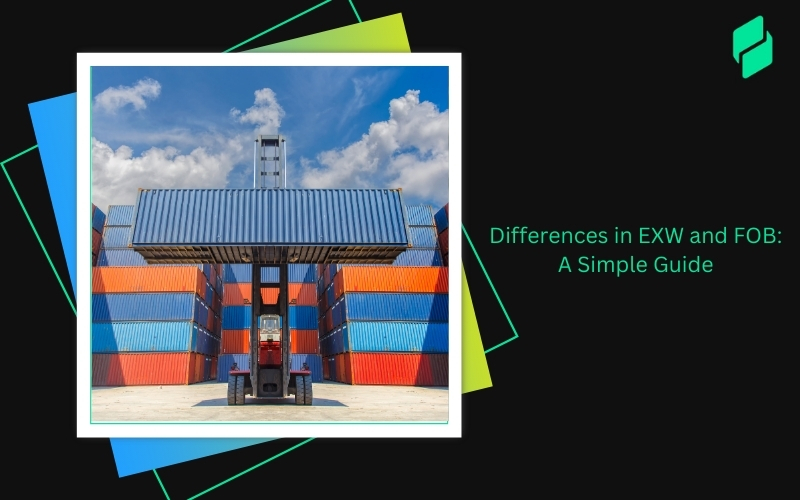Optimize your business: use unlimited savings with Pazago fulfilled now!
Get Started ->Every product’s journey starts long before it reaches a warehouse or customer. In procurement, this journey begins when you identify a need for raw materials or products and only ends when they arrive at your facility, ready for use.
According to a recent industry report, efficient procurement can significantly impact operational costs and profitability, especially when you consider that supply chain disruptions cost companies an average of $184 million annually.
This highlights the need for strategic procurement practices that go beyond cost-cutting. Companies must build resilient supplier networks, use data for smarter purchasing decisions, and maintain clear communication across the supply chain. These efforts not only reduce risk but also create a competitive edge in volatile markets.
This article will discuss procurement lead time, its role in the supply chain, and why it matters to your business. We’ll also explore key factors impacting lead time, practical strategies for optimization, and the role of technology in streamlining procurement processes.
What Is Procurement Lead Time?

Procurement lead time refers to the total time it takes from placing an order for goods or materials to their arrival at your designated location. This timeframe includes every key stage of the procurement cycle:
- Internal approvals
- Purchase requisitions
- Supplier communications
- Production planning
- Raw material sourcing
- Manufacturing
- Quality inspections
- Packaging and labeling
- Shipping and logistics
- Customs clearance
- Final delivery
Typically measured in days or weeks, procurement lead time is a crucial supply chain KPI that directly impacts your ability to meet demand, manage inventory, and maintain production flow.
Businesses with long or unpredictable procurement lead times often face higher costs, excess inventory, or stockouts. On the other hand, companies that actively monitor and optimize their procurement lead times can reduce operating costs, improve cash flow, enhance supplier relationships, and respond more flexibly to market changes.
In industries where time is money, optimizing this metric can mean the difference between meeting production deadlines and losing to competitors.
Also Read: Understanding How a Logistics System Works and Its Main Components
Key Benefits of Optimizing Procurement Lead Time
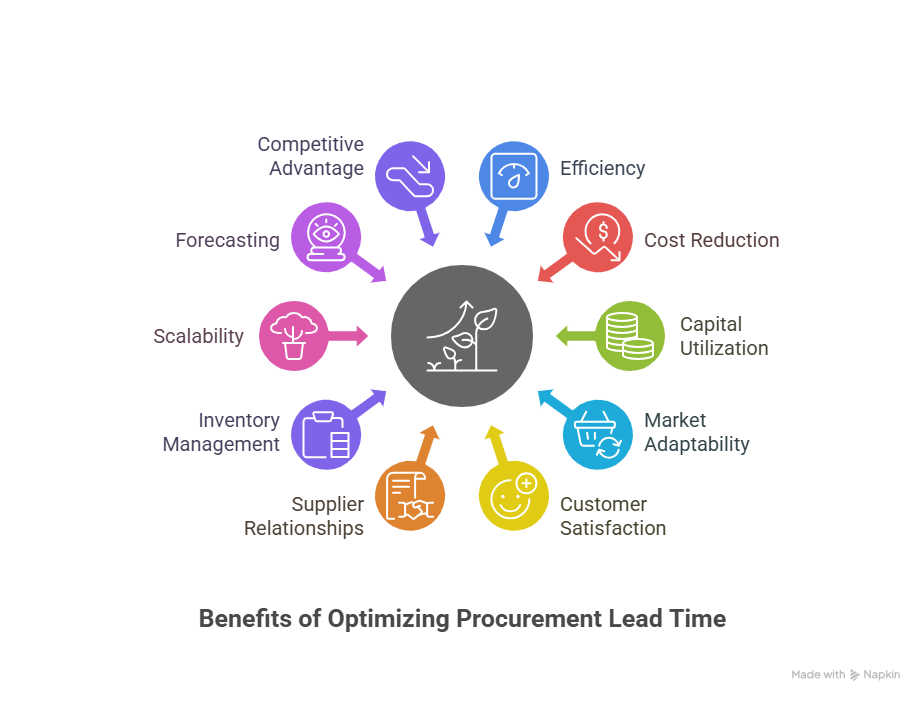
Businesses can improve their efficiency, reduce costs, and enhance customer satisfaction by reducing lead time. Here are the key benefits of optimizing lead time:
- Increased Efficiency in Supply Chain Operations: Faster procurement and production processes minimize delays across the supply chain, leading to better resource allocation, reduced downtime, and higher productivity. This ensures smoother operations and helps meet customer demands more effectively.
- Reduction of Labor and Operational Costs: Streamlining processes reduces the need for excess labor and minimizes inefficiencies. With fewer steps involved, businesses can lower operational overhead, improving profit margins and making better use of available resources.
- Enhanced Capital Utilization and Cash Flow: Optimized lead times lead to faster inventory turnover, freeing up capital that would otherwise be tied up in stock. This improves cash flow, allowing businesses to redirect funds toward other investments, such as expansion or innovation.
- Ability to Quickly Adapt to Market Changes: Shortened lead times allow businesses to respond swiftly to shifts in consumer demand or market trends. This agility increases competitiveness by enabling faster adjustments to product offerings, pricing, and production schedules.
- Improved Customer Satisfaction and Loyalty: Reducing lead time enables businesses to deliver products faster and more reliably, which improves customer satisfaction. Timely deliveries build trust and promote repeat business, increasing customer loyalty and driving long-term success.
- Better Supplier and Vendor Relationships: Optimized lead times lead to more predictable orders, helping suppliers plan their resources more effectively. This encourages stronger supplier relationships, potentially securing better pricing, discounts, and priority service, which benefits the entire supply chain.
- Reduction of Stockouts and Overstocking: With better lead time management, businesses can maintain accurate inventory levels, avoiding stockouts that lead to missed sales and excess inventory that ties up capital.
- Scalability and Growth: A well-optimized supply chain can handle increased volume without compromising quality or service. As businesses grow, having efficient lead times in place allows them to scale operations smoothly, meeting the demands of larger markets while maintaining operational efficiency.
- Improved Forecasting and Planning: By reducing lead times, businesses gain better visibility into their supply chain dynamics, allowing for more accurate demand forecasting and production planning.
- Competitive Advantage: Companies that optimize lead times can respond to market changes and customer demands faster than competitors. This agility gives them a significant edge, allowing them to capitalize on new opportunities and adapt to trends more quickly, securing their position in the market.
How to Calculate Procurement Lead Time
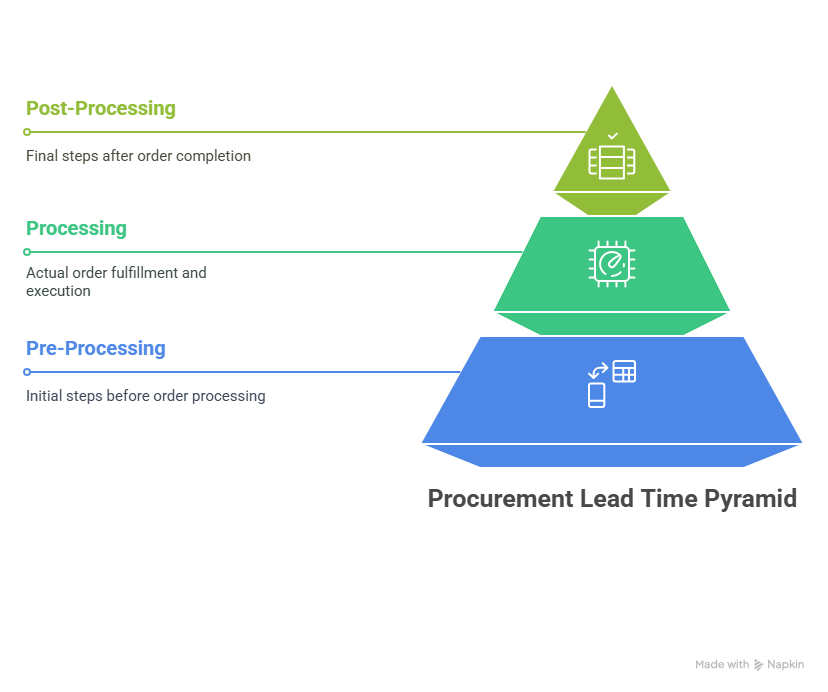
Calculating procurement lead time involves several steps to ensure that materials and products are delivered on time, avoiding production delays or missed sales opportunities. To calculate procurement lead time, use the following formula:
Procurement Lead Time = Pre-Processing Time + Processing Time + Post-Processing Time
Below are the steps you should consider taking while calculating procurement lead time:
1. List of Necessary Products and Materials
Create a detailed list of all required items, including quantities, specifications, and quality standards. Prioritize items based on their urgency and impact on production.
2. Determining Purchase Period and Safety Margins
Assess how long it takes to receive items after ordering and factor in safety margins for delays. Consider order frequency, production timelines, and supplier lead times.
3. Segregating Items with Longer Lead Times
Identify and monitor items with long lead times or critical production roles. Prioritize early ordering and track their status closely.
4. Computing Total Manufacturing and Waiting Times
Include supplier production time, shipping duration, and internal processing when calculating total lead time. Don’t overlook customs and administrative delays.
5. Reviewing Supplier Lead Times
Regularly update supplier lead time data, as it may change due to capacity, location, or shipping methods. Maintain open communication to adjust plans as needed.
6. Considering Transportation and Shipping Variabilities
Account for unpredictable delays from weather, customs, or congestion. Plan buffers in lead time estimates, especially for international orders.
7. Assessing Inventory Levels and Buffer Stock
Conduct regular inventory checks and maintain buffer stock for critical items. Use rotation systems like FIFO or LIFO to manage materials efficiently.
8. Using Automation and Procurement Software
Use procurement tools for real-time tracking, supplier monitoring, and historical data analysis. Automation enhances accuracy and speeds up processes.
9. Evaluating Historical Data and Performance Metrics
Review past orders, supplier reliability, and delay causes to refine lead time estimates. Use insights to improve planning and mitigate future issues.
10. Building Strong Supplier Relationships
Maintain clear communication and trust with suppliers to gain flexibility and better terms. Strong relationships lead to smoother, faster procurement.
Suggested Read: B2B Supply Chain Management and Software Solutions
The Role of Procurement Lead Time in the Supply Chain
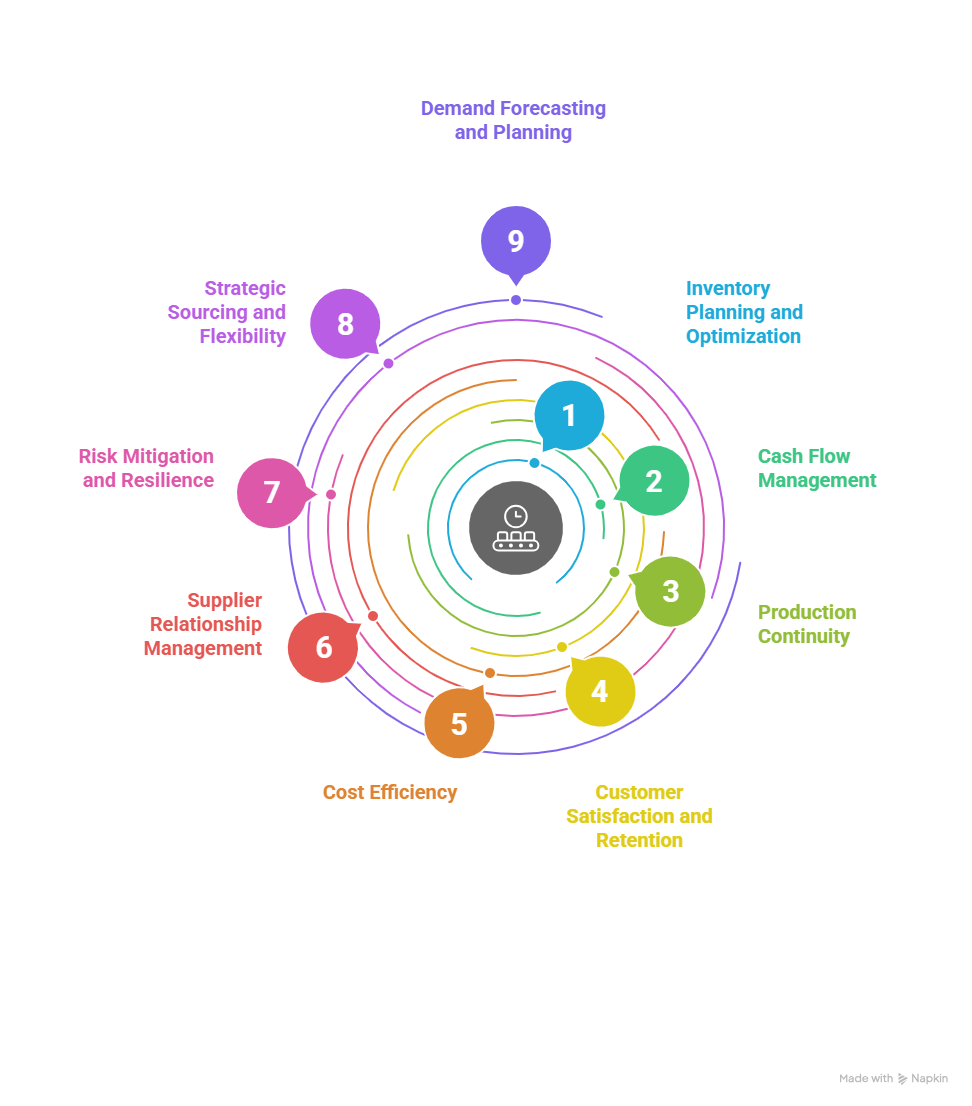
Procurement lead time acts as a critical performance indicator (KPI) for procurement activities, reflecting the efficiency of an organization’s sourcing processes. This metric impacts multiple aspects of supply chain management, from cost control to customer satisfaction. Here’s why it matters:
- Inventory Planning and Optimization: Properly calculated lead times help businesses maintain optimal inventory levels, reducing the risk of overstock or stockouts and minimizing carrying costs.
- Cash Flow Management: Shorter lead times reduce the need for large inventory buffers, freeing up capital for other business priorities.
- Production Continuity: Reliable lead times keep production lines operational, reducing the risk of costly downtime and missed customer commitments.
- Customer Satisfaction and Retention: Consistent lead times improve customer trust, reduce order cancellations, and boost overall brand loyalty.
- Cost Efficiency: Lower lead times can reduce logistics expenses, limit storage costs, and improve overall operational efficiency.
- Supplier Relationship Management: Strong supplier relationships improve response times, reduce order delays, and ensure priority support during peak demand periods.
- Risk Mitigation and Resilience: Well-managed lead times reduce the impact of supply chain disruptions, enhancing overall business continuity.
- Strategic Sourcing and Flexibility: Working with multiple suppliers or diversifying sourcing regions minimizes dependency on a single vendor, reducing lead time variability.
- Demand Forecasting and Planning: Accurate demand forecasting aligns procurement with production needs, reducing the likelihood of stockouts and emergency orders.
A well-managed lead time ensures that production lines remain operational, customer orders are fulfilled without delay, and businesses can respond to market changes more effectively. In a competitive environment, this level of agility often translates to a significant market advantage.
Factors Affecting Procurement Lead Time
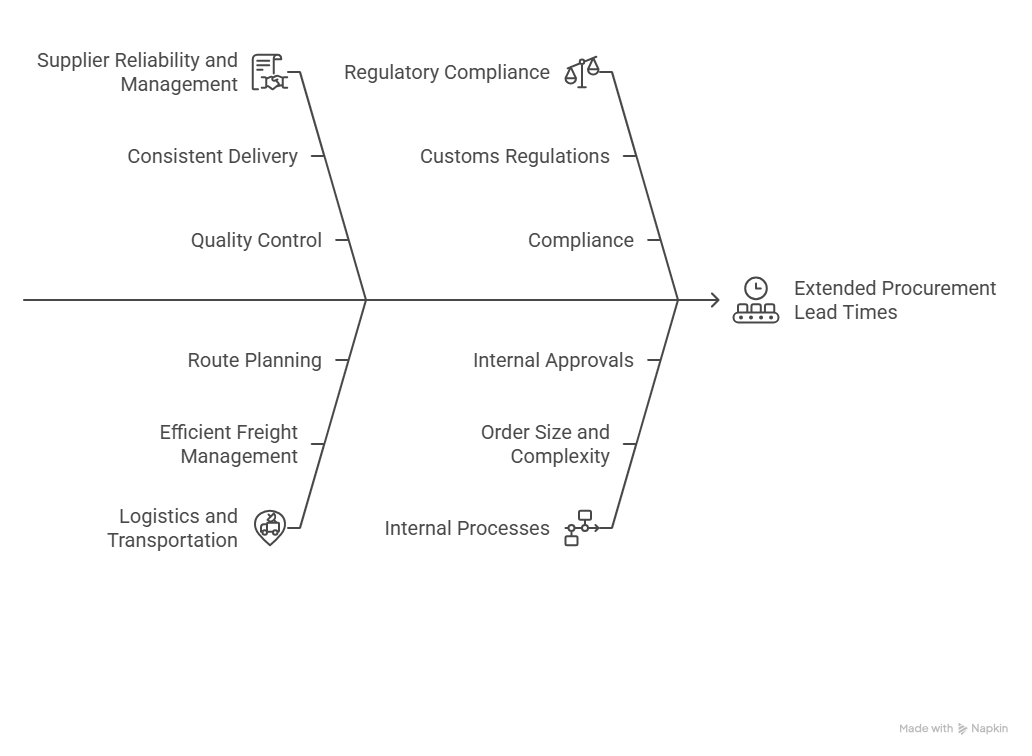
Several factors influence procurement lead time, ranging from supplier performance to logistical challenges and regulatory requirements. Understanding and managing these factors can help businesses simplify their procurement processes, reduce delays, and improve overall efficiency. Here are the key factors that affect procurement lead time.
- Supplier Reliability and Management: Dependable suppliers reduce lead times through consistent delivery, quality control, and clear communication. Strong relationships and management practices lower risks and streamline procurement.
- Geographic Location of Suppliers: Longer distances often mean longer transit times. Proximity to suppliers generally leads to faster, more reliable deliveries.
- Shipping and Transportation Logistics: Efficient freight management, route planning, and tracking help avoid delays. Reliable logistics ensure predictable delivery schedules.
- Customs Regulations and Compliance: International shipments face delays due to complex customs procedures. Staying compliant and informed minimizes border-related disruptions.
- Order Size and Complexity: Large or complex orders take longer due to extended production or quality checks. Simpler orders typically move faster through the supply chain.
- Inventory Management and Stock Levels: Low stock or stockouts delay procurement. Accurate forecasting and stock tracking help maintain a steady supply.
- Production Capacity and Workload of Suppliers: Overloaded suppliers may delay deliveries. Confirming capacity during peak periods helps prevent extended lead times.
- Supplier Financial Stability: Unstable suppliers risk delays from labor or production issues. Financially sound partners ensure more reliable delivery.
- Technology and Communication Systems: Digital tools speed up order processing and shipment tracking, and tech-savvy suppliers enable faster procurement cycles.
- Demand Fluctuations and Seasonality: High demand during peak seasons can increase lead times. Planning helps avoid delays during these periods.
- Internal Processes and Approvals: Slow internal approvals can hold up orders. Streamlined workflows and better coordination speed up procurement.
You Might Also Like: Freight Optimization and Logistics Software
Strategies to Optimize Procurement Lead Time
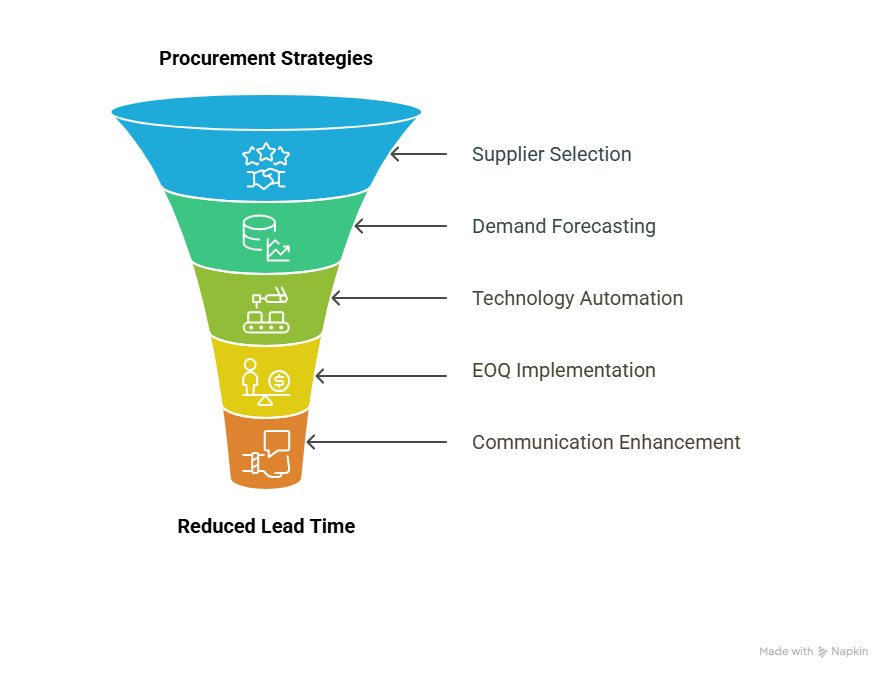
Reducing procurement lead time is crucial for enhancing operational efficiency, improving cash flow, and maintaining a competitive edge in the market. Delays in procurement can lead to stockouts, production halts, and customer dissatisfaction.
Organizations can simplify their procurement process and ensure the timely delivery of goods and services by implementing strategic measures such as optimizing supplier relationships, using technology, and improving demand forecasting. The following strategies offer actionable solutions to reduce procurement lead time and enhance overall supply chain performance.
- Optimizing Supplier Selection and Contracts: Choose reliable suppliers with strong performance records and flexible terms. Negotiate clear delivery schedules, penalties for delays, and options for urgent orders.
- Implementing Accurate Demand Forecasting: Use data and analytics to predict demand accurately. This reduces last-minute orders and helps suppliers plan more effectively.
- Using Technology for Process Automation: Automate order creation, tracking, and communication with ERP and procurement software. This improves accuracy, speeds up processes, and reduces manual errors.
- Adopting Economic Order Quantity (EOQ) Methods: Use EOQ to balance order size and inventory costs. It helps prevent overstocking and stockouts, streamlining procurement.
- Enhancing Communication and Collaboration with Suppliers: Maintain open, consistent communication with suppliers. This alignment reduces misunderstandings and speeds up the procurement cycle.
- Establishing Strategic Partnerships: Form long-term relationships with key suppliers. Strategic partnerships lead to better service, faster deliveries, and priority handling.
- Consolidating Orders and Streamlining Processes: Combine orders to cut costs and reduce delays. Standardizing processes across departments further accelerates procurement.
- Continuous Performance Monitoring and Improvement: Track supplier KPIs and review processes regularly. Early issue detection and ongoing improvements help minimize lead times.
How Pazago Optimizes Procurement Lead Time Management

Managing procurement lead time goes beyond placing orders and waiting for delivery. It involves supplier selection, order management, production planning, quality control, and efficient communication across the supply chain. For businesses, reducing lead times means lower carrying costs, faster order fulfillment, and improved customer satisfaction.
Here’s a breakdown of the key factors affecting procurement lead time and how platforms like Pazago streamline these processes:
Finding reliable suppliers is the first step in shortening lead time. This involves evaluating production capacity, quality standards, pricing, and geographic proximity. Pazago simplifies this by connecting businesses with pre-vetted suppliers, reducing the time spent on due diligence and ensuring consistency in supply quality.
Manual purchase order processing can slow down the entire procurement cycle, increasing the risk of delays and errors. Centralized order management systems like Pazago provide real-time visibility into order status, automate routine workflows, and reduce administrative overhead, keeping the supply chain moving smoothly.
Clear communication between buyers, suppliers, and logistics partners is essential for avoiding delays. Pazago’s integrated communication tools keep all parties aligned, reducing the back-and-forth typical in manual processes and minimizing the risk of miscommunication.
Knowing the status of each order at every stage is critical for effective procurement management. Pazago’s real-time tracking features allow businesses to monitor order progress, anticipate potential disruptions, and make informed decisions to keep operations on schedule.
Supply chain disruptions can significantly impact lead times. Pazago helps businesses assess potential risks, from supplier shortages to geopolitical issues, and implement contingency plans, ensuring a more resilient procurement process.
Managing payments across multiple suppliers can complicate cash flow and extend lead times. Pazago integrates secure, cross-border payment solutions, reducing the time spent on financial coordination and minimizing payment delays.
Trusted platforms like Pazago provide the digital infrastructure needed to simplify these processes, allowing businesses to stay competitive and responsive to market changes.
Conclusion
The businesses that thrive today are the ones that move fast, reduce delays, and build resilient, cost-effective supply chains. Taking control of your procurement lead time doesn't just cut costs; it sets the stage for faster growth, stronger supplier relationships, and happier customers.
But getting there takes more than spreadsheets and endless email chains. It demands real-time visibility, smooth communication, and tools that work for you, not the other way around.
With Pazago, you get a partner in optimization. From centralized order tracking and automated workflows to simplified cross-border payments, Pazago helps you with all of it and more.
When your procurement process flows better, everything else follows.
Ready to stop reacting and start leading?
Take the first step, book your demo today, and see how Pazago can transform your procurement journey.


.png)


.png)



